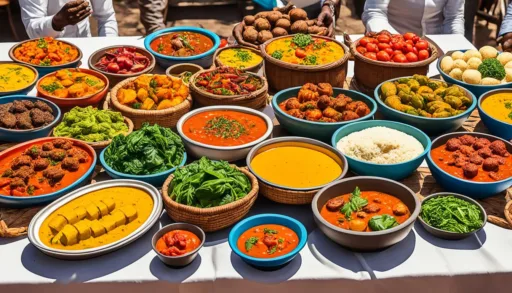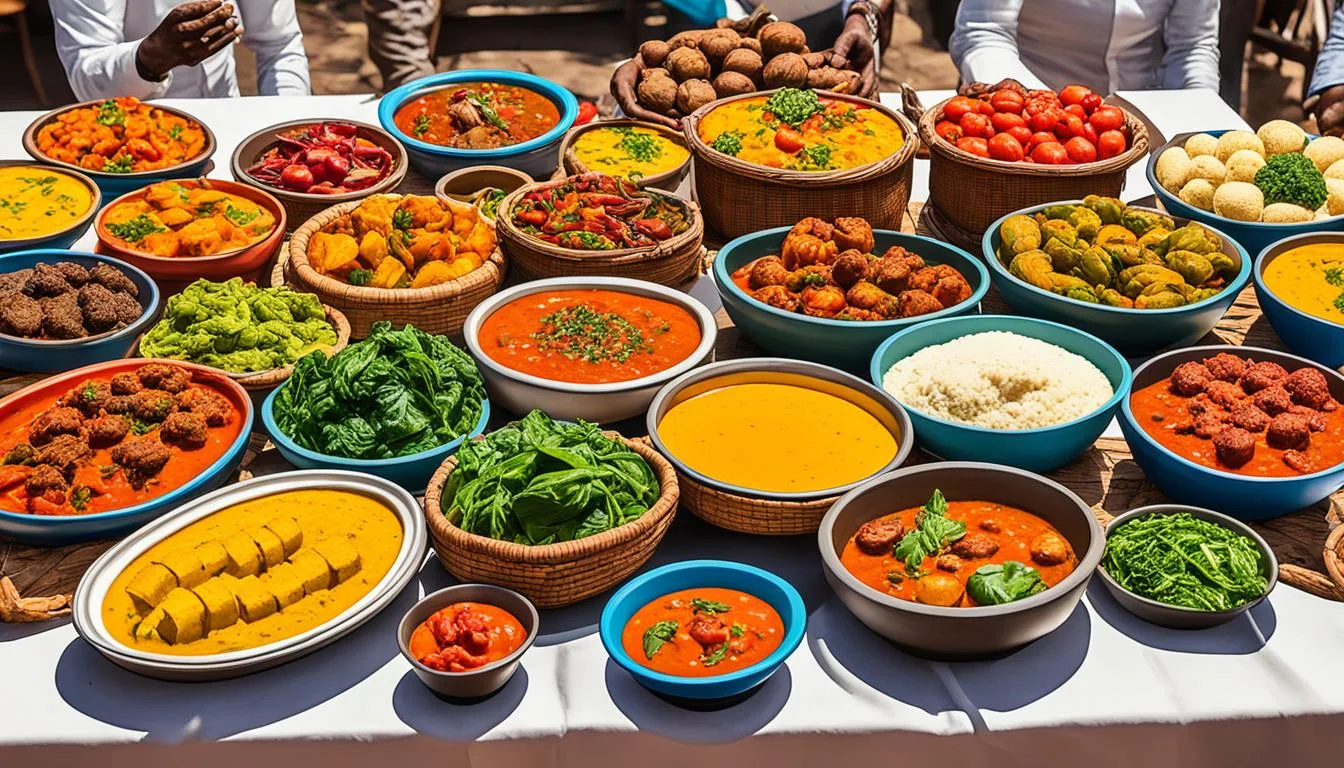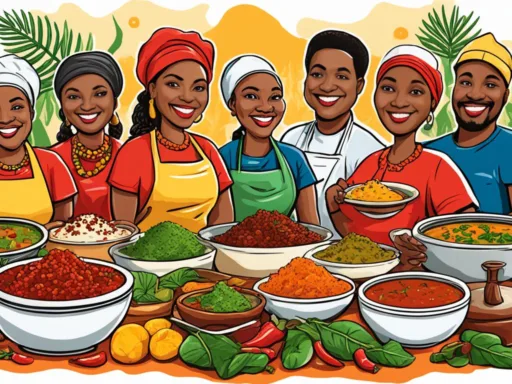Did you know that the small Central African country of Cameroon boasts an unparalleled diversity of over 250 ethnic groups and as many distinct culinary traditions? This staggering mosaic of flavors makes the nation an endlessly fascinating destination for Cameroonian Food Discovery. From the hearty, savory delights of the northern highlands to the bold, spicy tastes of the coastal lowlands, every plate tells a story. This exploration into the heart of Traditional Cameroonian Dishes reveals the depth and breadth of Authentic Cameroonian Meals, each a tessellation of the country’s rich cultural tapestries. Join us as we uncover the vibrant hues and tastes that define Cameroon’s culinary landscape.
Key Takeaways
- Cameroon’s cuisine is a reflection of its cultural diversity, with over 250 ethnic groups contributing to its gastronomic tapestry.
- Exploring traditional dishes such as achu soup offers a glimpse into the country’s rich culinary traditions and local practices.
- Authentic Cameroonian meals often incorporate ingredients like cocoyams and palm oil, central to the nation’s food heritage.
- Food in Cameroon is entwined with social functions, playing a vital role in festivities, ceremonies, and community bonding.
- Discovering Cameroonian food is about experiencing the harmonious interplay of geography, culture, and flavors that create a unique and inviting cuisine.
An Introduction to Cameroonian Cuisine
The interwoven flavors of Cameroonian cuisine paint a vivid image of its cultural expanse and agricultural wealth, uniting the traditions and innovations that have shaped the Cameroonian table into a vibrant palette of local Cameroonian flavors. As we delve into the heart of African food exploration, the rich tapestry of flavors and preparations serves not just as means for sustenance but as a storyteller of the nation’s history, geography, and soul.
The Culinary Tapestry of Cameroon
The myriad taste profiles embedded within Cameroonian cuisine are a reflection of the land’s diversity. With each regional dish, there’s a story of the people, their lifestyle, and the natural bounty that shapes their culinary expressions. From the hearty Bornhouse Plantain, pivotal to the Northwest diet, to the sumptuous Khati-khati, Cameroonian cuisine offers a revelatory experience to those eager to explore its depth and complexity.
The Role of Geography and Culture in Cameroonian Food
Embedded deeply in the essence of Cameroonian cuisine is the role played by geography and culture. These aspects fuse harmoniously, yielding an array of dishes such as fufu corn and water fufu, emblematic of local tastes and resources. From the highland regions to the coastal plains, each locality adds its unique brushstroke to the overall gastronomic canvas. Celebratory meals, while marking events like Guidar naming ceremonies or Beti post-burial gatherings, fortify the ties of community and continuity through the universal language of food.
| Region | Dish | Main Ingredients | Occasion |
|---|---|---|---|
| Northwest | Bornhouse Plantain | Plantains, spices, herbs | Everyday & celebratory |
| Nso | Khati-khati | Chicken, native spices | Formerly secret societies, now widespread |
| Guidar | Fufu Corn | Maize flour, water | Naming ceremonies |
| Beti | Water Fufu | Cassava flour, water | Post-burial meals |
Cameroonian Food Discovery: A Dive into Traditional Ingredients
The quest for authentic food experiences in Cameroon often leads to a rich tapestry of traditional Cameroonian dishes, each telling its own story through the ingredients it features. Primary among these ingredients are the nutritional powerhouses—cocoyams and cassava—whose versatility and compatibility with various recipes have solidified their status in local cuisine. The exploration of these staple foods reveals their evolution from traditional usage to their incorporation into innovative, modern culinary practices.
The Foundation of Flavors: Staple Ingredients
As you delve into the world of Cameroonian recipes, the prominence of certain staple items becomes apparent. These are not merely ingredients but the foundational blocks that give Cameroonian food its unique flavor profile. For instance, njama njama, a beloved green vegetable dish, is often paired with these starchy sides, creating a harmonious balance between earthy greens and the comforting richness of processed cocoyams or cassava.
From Cocoyams to Cassava: A Look at Native Staples
Cocoyams and cassava, native to the fertile land of Cameroon, symbolize the ingenuity of Cameroonian cooking, adapting to both time-honored and current tastes. The starch from these staples is utilized to produce an array of beloved dishes; from traditional Cameroonian dishes like fufu, which pairs strikingly with the bold flavors of the national dish ndolé, to more experimental offerings such as cassava fries, which bring a contemporary twist to the Cameroonian palate.
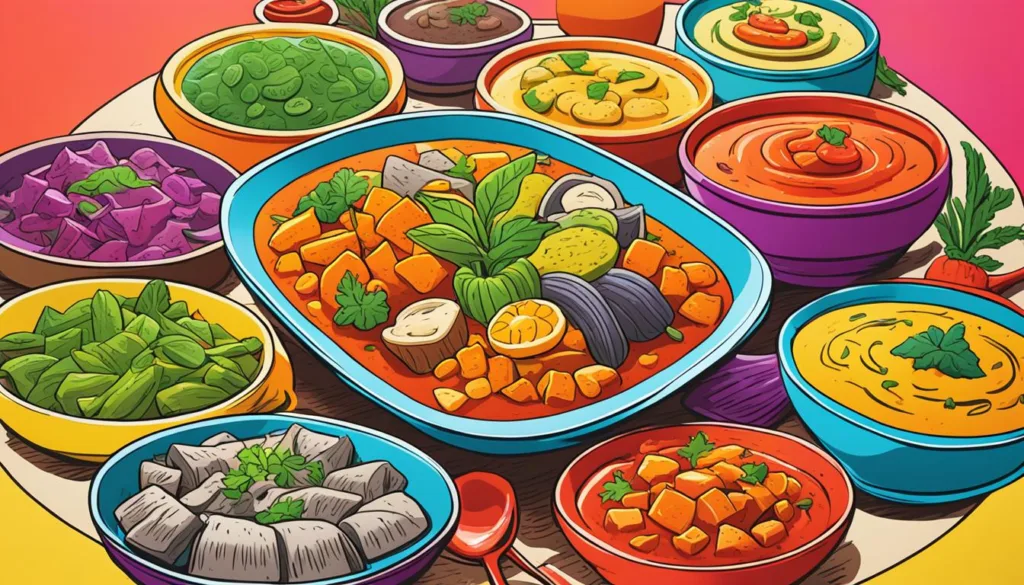
Cameroon’s traditional dishes showcase the versatility of these ingredients, with recipes that invite locals and visitors alike to savor these staples in both their simplest form and through more complex, flavor-layered preparations. In this journey, the sheer breadth of Cameroonian recipes on offer assures that the food experiences in Cameroon are bound to be as diverse and rich as the nation’s cultural tapestry.
The Unique Techniques of Cameroonian Cooking
As we delve into the culinary heart of Africa, we cannot overlook the distinctive food experiences in Cameroon that are steeped in tradition and refined over centuries. The art of Cameroonian cooking is a living testament to the skill and creativity embedded within the nation’s cuisine. From the bustling markets where spices emit their fragrant call to the quiet kitchens where traditional dishes come to life, every aspect of Cameroonian cooking reverberates with culture and history.
The Art of Pounding Fufu: More Than Just a Dish
One of the cornerstones of traditional Cameroonian dishes is the preparation of fufu. Known for its sticky texture and the ability to complement a variety of dishes, fufu is not just a staple food; it’s a culinary experience forged with rhythm and communal participation. The labor-intensive process involves pounding boiled yams, plantains, or cocoyams into a dough-like consistency, a task that strengthens communal bonds and infuses the dish with a sense of cultural continuity. This method of cooking represents the tangible heritage of Cameroon’s gastronomic identity.
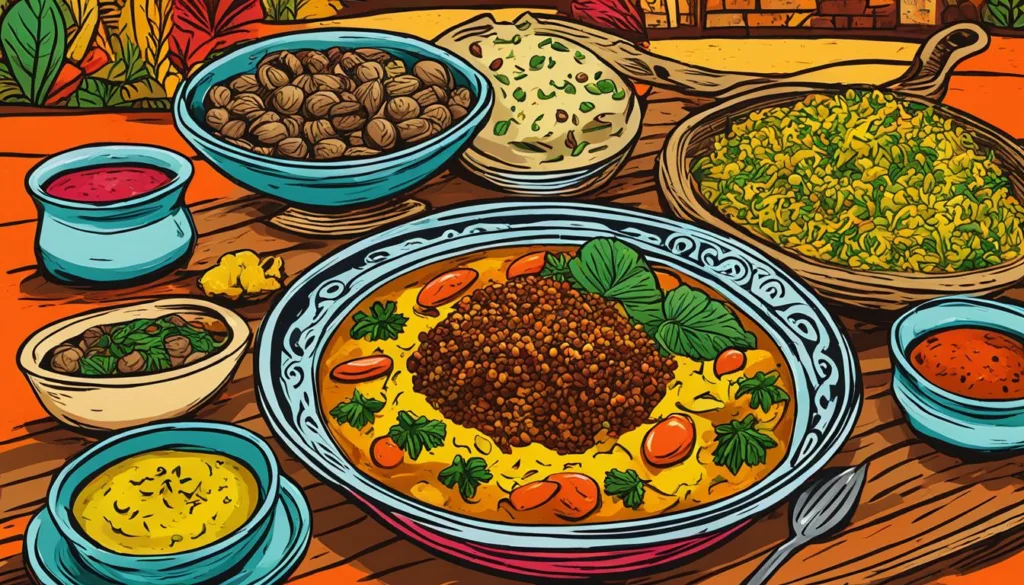
The Use of Kanwa and Ash: Traditional Science in Cuisine
Kanwa, a type of mineral potash, plays a scientific role in Cameroonian cuisine. Its chemical properties are utilized in the making of achu soup by helping to emulsify the fats in palm oil, much like soap traps and dissolves oil. This blend of ancient culinary science with traditional preparation methods showcases the resourceful and adaptive nature of Cameroonian cooking. It is an eloquent example of how food preparation in Cameroon is as much about maintaining the delicate balance of flavors as it is a showcase of ancestral wisdom and innovation.
| Dish | Main Ingredient | Preparation Technique | Region of Origin |
|---|---|---|---|
| Achu Soup | Cocoyams | Emulsifying fats with kanwa | Northwest |
| Fufu | Yams/Plantains/Cocoyams | Pounding to a doughy consistency | Widespread |
In conclusion, embracing the food experiences in Cameroon is essential for understanding a culture where each morsel carries a narrative of resilience, community, and innovation. The time-honored crafts of fufu pounding and the scientific layers behind the use of kanwa are more than just aspects of preparing meals; they are the threads that weave the vast tapestry of Cameroonian cuisine.
Authentic Cameroonian Meals: A Regional Perspective
Cameroon’s culinary diversity is a testament to its rich patchwork of climates and cultures. A journey through the country’s geography is akin to a food discovery tour, with local Cameroonian flavors revealing themselves in traditional Cameroonian dishes unique to each area.
The Coastal Influence on the Littoral Region’s Dishes
In the humid embrace of Cameroon’s Littoral region, local cuisine takes a pescatarian twist, incorporating a bountiful catch from the Atlantic Ocean. Dishes such as ndole and mbongo tchobi epitomize the local Cameroonian flavors, where the generosity of the coastline infuses each meal with the essence of the sea. Spices form the quintessence of these recipes, setting palates ablaze with flavors that resonate with the rhythm of the waves.
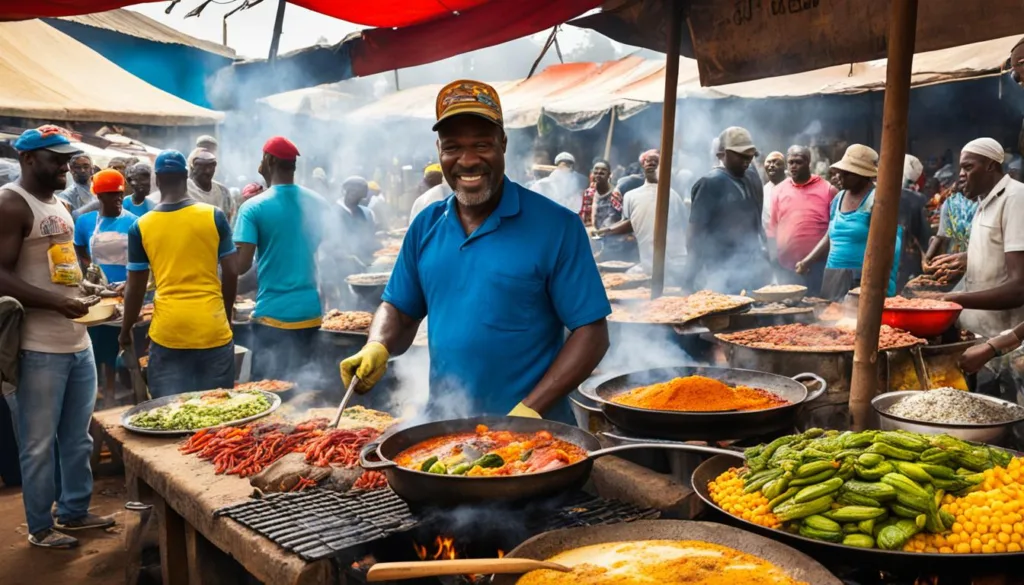
Savoring the Sudano-Sahelian Aromas of the Northern Regions
The Sudano-Sahelian zone, characterized by its semi-arid climate, offers a stark contrast with its focus on pastoral cuisine. Here, the aromatic richness of the dishes like kilishi speaks to the Cameroonian food discovery in the northern plains. Cattle-raising traditions of the Hausa along with the bold flavors inherent to this territory ensure that every bite carries the essence of the land and its history.
Whether it’s through the lens of the Littoral’s seafood mastery or the Northern regions’ robust, meaty offerings, Cameroon invites gourmands and curious travelers alike to partake in a culinary journey like no other, where every dish is a chapter in the country’s unfolding story. Exploring traditional Cameroonian dishes serves not only to satiate hunger but also to foster a profound appreciation for the vibrant, yet often overlooked, Cameroonian food landscape.
Food Experiences in Cameroon: Must-Try Dishes
Embark on a flavorful journey through Cameroon, where every meal tells a story of culture and tradition. Food connoisseurs in pursuit of authentic Cameroonian cuisine will find themselves enchanted by the depth and variety of tastes the nation has to offer. Indeed, the widespread adoration for Cameroonian food experiences stems from the nation’s ability to harmoniously blend natural ingredients and time-honored cooking techniques into every dish.
Without a doubt, some must-try Cameroonian foods have gained legendary status among locals and visitors alike. Specifically, achu soup and ndolé have emerged as culinary icons, inviting everyone to appreciate the rich tapestry of Cameroonian flavors. Let’s delve deeper into these dishes:
A Delicacy to Remember: Tasting Achu Soup
From its origins in the Northwest, the revered achu soup captures the essence of Cameroon with its vibrant flavors and elaborate preparation. Eating achu, you’ll encounter a symphony of textures from silky cocoyam fufu to a palatable, golden-hued sauce with kanwa, showcasing a perfect example of the unparalleled food experiences in Cameroon.
The Richness of Ndolé: The National Dish of Cameroon
Ndolé, often hailed as Cameroon’s national dish, provides an unmissable culinary experience that captivates all who taste it. This dish, with its harmonious merger of bitter leaves, nut-based thickening agents, and a choice of meats or fish, presents a lavish feast that remains irresistibly evocative of the nation’s cultural and culinary spirit.
Cameroon undoubtedly promises a gastronomic adventure rich in history and flavor. Whether you’re seeking the comforting pleasure of a well-known favorite or the thrill of discovering new tastes, the food landscape of Cameroon will not disappoint.
Cameroonian Recipes: Cooking with Local Spices and Herbs
The culinary artistry of Cameroon is deeply intertwined with its rich array of local spices and herbs, which are pivotal in creating the authentic traditional Cameroonian dishes that capture the essence of the nation’s food experiences. These seasonings do more than just tantalize the palate; they also embody the health-giving practices inherent to Cameroonian culture.
Infusing Meals with Exotic Spices: From Penja Pepper to Country Onions
Culinary adventurers and connoisseurs alike cherish the bold and vibrant flavors that characterize Cameroonian recipes. Spices such as the fiery Penja pepper, grown in the volcanic soils of the Penja Valley, imparts a distinct heat and flavor complexity to dishes. Similarly, country onions, with their potent fragrance, are fundamental in crafting an array of sauces and marinades, further enriching the local Cameroonian flavors of traditional stews and meats.
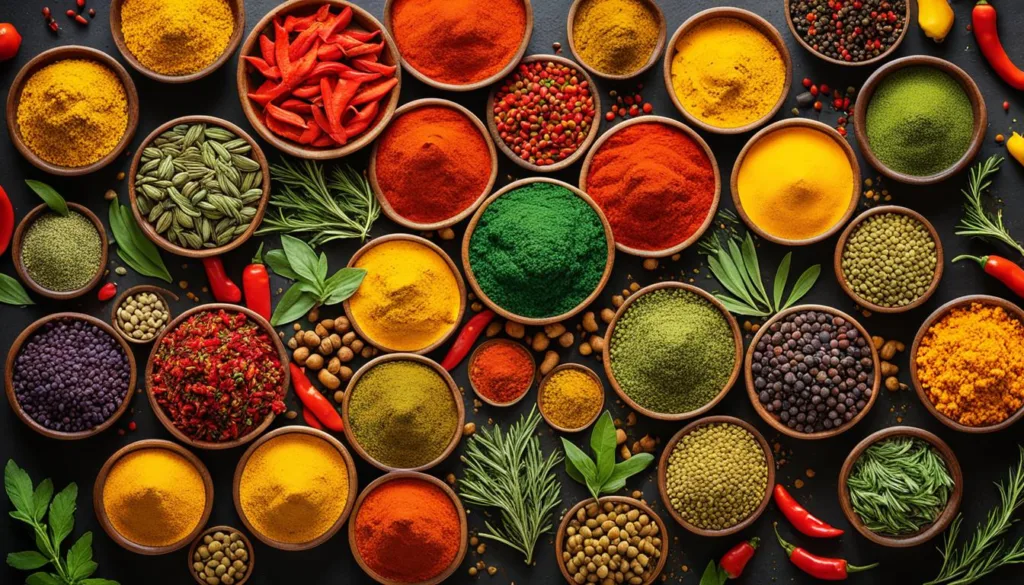
Herbs that Heal: The Medicinal Edge in Cameroonian Cuisine
Herbs in Cameroon play a dual role—culinary and medicinal. Local favorites such as bitter leaf, parsley, and eru are not only imperative for their flavor contributions but are also appreciated for their purported healing properties. Cameroonians often incorporate these herbs into their meals, believing in their power to improve wellbeing and prevent illness. This practice underlines the connection between Cameroonian cuisine and its traditional healing arts, an integral part of the local culture.
Delving into the world of Cameroonian spices and herbs reveals a fascinating aspect of the country’s gastronomy, where every meal is a celebration of local flavors and each recipe is a testament to the country’s rich botanical heritage.
Celebrating Local Cameroonian Flavors at Festivals
Cameroon’s rich cultural tapestry unfolds in vibrant colors and enticing aromas at its numerous festivals, where the celebration of food is as important as the festivities themselves. These gatherings are profound expressions of heritage, with Cameroonian cuisine taking center stage, inviting locals and visitors alike to partake in an African food exploration that tantalizes the senses and nourishes the soul.
Cultural Festivities and the Foods That Define Them
In Cameroon, each festival is an opportunity to showcase the diversity of local Cameroonian flavors. From the coast to the mountains, every community has cherished dishes that form an integral part of their celebrations. These dishes are not just sustenance; they are a vibrant narrative woven into the country’s social fabric, capturing hearts through every shared meal and every spoonful of tradition.
- Ndolé – Often highlighted in festive spreads, this hearty stew is a testament to Cameroon’s love for greens, nuts, and meats.
- Koki Corn – This bean cake wrapped in plantain leaves is a delicacy that symbolizes togetherness, often served during holidays and special occasions.
Communal Eating: A Slice of Cameroonian Life
The act of communal eating in Cameroon transcends mere dining; it is a cherished ritual that strengthens community bonds and affirms collective identity. Whether seating around a large bowl of achu or sharing a drink of palm wine, these moments encapsulate the spirit of African togetherness and the joy found in shared experiences. The unity fostered by communal eating at such events is a poignant reminder of how integral food is to Cameroonian life and the continuation of its rich traditions.
- Bornhouse Plantain – Served during birth celebrations, its symbolism for fertility and prosperity is as rich as its flavors.
- Bili bili – This fermented beverage made from sorghum is a communal favorite in the hot climates of the Extreme North, often associated with leisure and festivity.
African Food Exploration: Cameroon’s Fusion and Variations
Within the crucible of African food exploration, Cameroonian cuisine stands out as a testament to cultural syncretism and gastronomic innovation. As epicures delve into authentic Cameroonian meals, they find a culinary narrative rich with stories of fusion, variation, and resilience. The nation’s food scene is not just about preserving tradition; it’s also about embracing change, adopting flavors, and courteously nodding to its diverse influences. Through Cameroonian Food Discovery, what emerges is a compelling tapestry of tastes that invites both locals and foreigners to explore and celebrate.
Culinary Crossroads: Borrowing and Adapting from Neighbors
Cross-border culinary exchanges have long played a role in shaping the dishes we now identify as distinctly Cameroonian. The ebb and flow of spices, techniques, and dishes with neighbors have contributed to an ongoing dance of give-and-take. These mutual exchanges foster a culinary crossroads where dishes are not static relics of the past but are dynamic embodiments of regional collaboration. This interplay of cultures is vividly displayed in markets and kitchens across the country, inviting diners to trace the journey of each ingredient and discover how they combine to create the vibrant patchwork of flavors that characterizes Cameroonian cuisine.
The Impact of Colonization on Cameroonian Cuisines
The waves of European influences that lapped at Cameroon’s shores have forever altered the culinary landscape, introducing not just new ingredients but entirely new paradigms of cooking. Colonization’s impact is etched in the gastronomy, interweaving foreign staples with indigenous methods to enrich the diversity of Cameroonian tables. While these historical events have broadened the flavor spectrum, they haven’t overshadowed the dedication to authenticity. Cameroon has skillfully blended these vestiges with its age-old traditions to solidify its stature in African food exploration, presenting Cameroonian Food Discovery as a journey of complex layers and delightful surprises.
FAQ
What makes Cameroonian cuisine unique?
Cameroonian cuisine is unique because of its vibrant blend of over 200 ethnic influences, creating an eclectic mix of flavors, ingredients, and cooking techniques. This results in dishes like achu soup and ndolé, which embody a rich culinary heritage and geographical diversity.
How does geography influence traditional Cameroonian dishes?
The geography of Cameroon, from the coastline to the arid northern regions and the fertile western highlands, deeply impacts the food available and the type of dishes prepared. For instance, coastal dishes feature more fish, while northern cuisine incorporates sun-dried meats like kilishi.
What are some staple ingredients in Cameroonian food?
Staple ingredients in Cameroonian cuisine include cocoyams, cassava, maize, and a range of spices and herbs like Penja pepper and country onions. These staples are central to many traditional Cameroonian dishes and reflect the agricultural bounty of the country.
What are some must-try dishes for someone new to Cameroonian food?
For anyone exploring Cameroonian food, achu soup and ndolé are must-try dishes. Achu soup, with its rich, spicy sauce, and ndolé, often considered the national dish, offer a taste of the country’s diverse flavors and cooking traditions.
Can you describe the significance of spices and herbs in Cameroonian recipes?
Spices and herbs play a dual role in Cameroonian recipes. They infuse the dishes with distinctive, robust flavors and often provide medicinal benefits, reflecting the importance of food for both taste and health in Cameroonian culture.
How do food and culture intersect in Cameroonian celebrations?
In Cameroon, cultural celebrations are closely tied to food, with special dishes and drinks forming an essential part of communal festivities. Sharing a meal during these events strengthens social bonds, fosters community spirit, and preserves traditional flavors and practices.
How has Cameroonian cuisine evolved over time?
Cameroonian cuisine has evolved by integrating influences from neighboring countries, colonization, and the global culinary scene. This has led to fusion dishes that maintain their Cameroonian roots while incorporating new flavors and techniques.
Are there regional differences within Cameroonian cooking methods?
Yes, regional differences significantly influence Cameroonian cooking methods. The Littoral region’s dishes, for example, make extensive use of fish and spices, while in the northern regions, methods like sun-drying meats are popular due to the climate.
How are traditional spices used in modern Cameroonian cuisine?
Traditional spices are often creatively adapted in modern Cameroonian cuisine. For example, classic spices are now used in contemporary dishes such as cassava fries and pancakes, showcasing the culinary evolution while respecting the flavors of tradition.
What role does communal eating play in Cameroonian society?
Communal eating is a cornerstone of Cameroonian society, highlighting how meals are more than just sustenance. Eating together is an act that brings people together, celebrates traditions, and plays a vital role in social and family structures.
